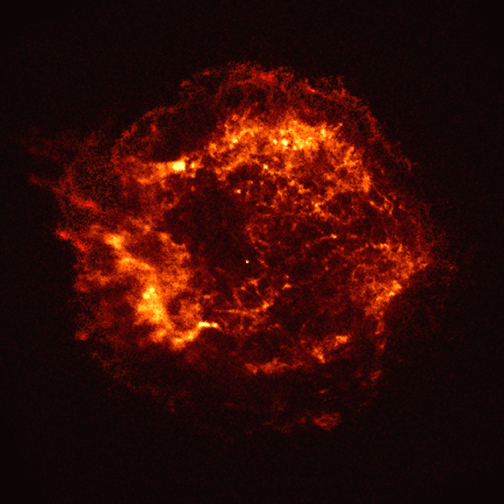
 Credit: Chandra Observatory
Credit: Chandra Observatory
Chandra Observation of the Supernova Remnant Cas A
NASA's Chandra X-ray Observatory is the third of NASA's "Great
Observatories". This telescope is designed to detect and image X-ray
emission from stars, black holes and galaxies with better spatial and
spectral resolution than any other X-ray observatory. Chandra was
deployed by Space Shuttle Columbia in July of 1999. One of the first
observations made by Chandra is this image of the X-ray emission
from the supernova remnant Cassiopeia A.
Cassiopeia A, or Cas A, is the remains of a massive star that exploded
around three hundred years ago. The material from the explosion is rushing
outward at supersonic speeds in excess of ten million miles per hour. As
this matter crashes into gas that surrounded the former star, shock waves
heat the ejected matter to temperatures in excess of fifty million degrees.
This hot material produces the X-ray emission seen in this image, which was
made by the Advanced
CCD Imaging Spectrometer (ACIS) instrument on Chandra. The
colors in this picture show the brightness of the X-ray emission, where
yellow reveals the areas with the most intense x-ray emission. A major
discovery already made by Chandra is the detection of the small
bright point in the middle of the remnant, which many astronomers believe
to be the "corpse" of the exploded star (probably either a neutron star or
black hole).
Last Week *
HEA Dictionary * Archive
* Search HEAPOW
* Education
Each week the HEASARC
brings you new, exciting and beautiful images from X-ray and Gamma ray
astronomy. Check back each week and be sure to check out the HEAPOW archive!
Page Author: Dr. Michael F.
Corcoran
Last modified September 27, 1999


